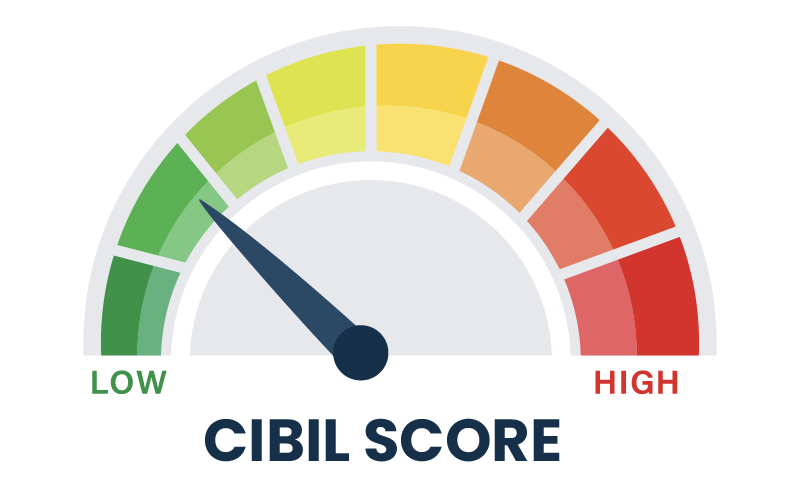In the world of lending, your credit score isn’t just a number—it’s your financial fingerprint. When you set out to secure a personal loan, one of the first things lenders examine is your CIBIL score. Think of it as your credit report card, summarising how responsibly you’ve handled debt in the past.
But how high does this score need to be to unlock the loan you need? And what if your score isn’t quite there yet?
Let’s explore.
What Exactly is a CIBIL Score?
The personal loan credit score, commonly referred to as a CIBIL score, is a three-digit figure ranging from 300 to 900. It’s calculated based on your credit history, repayment patterns, credit card usage, and the diversity of your credit profile.
A higher score reflects disciplined financial behaviour—paying EMIs on time, keeping credit usage moderate, and avoiding excessive borrowing. Simply put, the closer your score is to 900, the more attractive you appear to lenders.
What Is the Minimum CIBIL Score for a Personal Loan?
There’s no universal rulebook, but most lenders in India consider 750 to be the minimum CIBIL score for personal loan approval. This is often the threshold that opens doors to favourable terms and competitive rates.
But, having a score slightly below 750 doesn’t automatically close those doors. Borrowers with scores in the 650–749 range may still be eligible, though often at a higher interest rate. If your score dips below 650, you may want to explore online personal loan options from fintech platforms that use alternative methods to assess eligibility.
Why Does This Score Hold So Much Power?
Imagine being a lender. You can’t meet every applicant personally. So how do you decide whom to trust?
This is where your CIBIL score for personal loan becomes your spokesperson. It influences:
- Loan Approval Speed: A high score can fast-track approval or even fetch you a pre-approved offer.
- Loan Terms: Expect better interest rates and repayment flexibility.
- Loan Size: A great score can unlock larger borrowing limits.
In the age of digital finance, some of the best loan app interfaces use AI to scan your score and credit patterns instantly. Your score often makes the decision before a human sees your application.
What Affects Your Credit Score?
If you’re unsure why your score isn’t where it should be, here are some common influences:
- Repayment Record: Late or missed EMIs bring your score down quickly.
- Credit Utilisation Ratio: Using over 40% of your limit regularly sends negative signals.
- Multiple Loans or Enquiries: Frequent applications can lower your score due to repeated hard credit checks.
- Credit Diversity: A mix of secured and unsecured credit is generally viewed more favourably.
- Length of Credit History: Longer, well-maintained credit histories are seen as reliable.
How to Improve Your Loan Eligibility
Improving your score—and thereby your loan chances—isn’t as daunting as it seems. Here’s how to begin:
- Pay on time: Set up auto-payments to avoid missed deadlines.
- Lower your credit usage: Aim for a ratio below 30–40%.
- Limit loan applications: Space out your credit inquiries.
- Check your credit report: Spot and rectify inaccuracies promptly.
Before you apply for a personal loan online, taking these steps could help shift the odds in your favour.
Can You Get a Loan with a Low Score?
Yes, it’s possible—but it requires a strategic approach. If your personal loan credit score is below the typical benchmark:
- Opt for a smaller loan: Lower amounts carry less risk and are more likely to be approved.
- Apply through the best loan app: Many digital platforms cater to a wider range of credit profiles.
- Add a co-applicant: Their good score can help offset yours.
- Secure the loan: Offering collateral or proof of consistent income can support your application.
Digital lenders may also offer flexible approvals using non-traditional metrics, especially if you apply for a personal loan online.
Final Thoughts
Your credit score is more than a number—it’s the starting point of your loan journey. While a minimum CIBIL score for personal loan approval is typically 750, borrowers with lower scores still have viable options, especially through alternate lending channels.
Before applying, assess your current financial standing, plan your EMIs wisely using a personal loan EMI calculator, and explore lenders who best align with your profile. Whether you’re borrowing through a traditional bank or the best loan app on your phone, being informed about your score—and how to improve it—can unlock smarter borrowing opportunities.









Leave a Reply